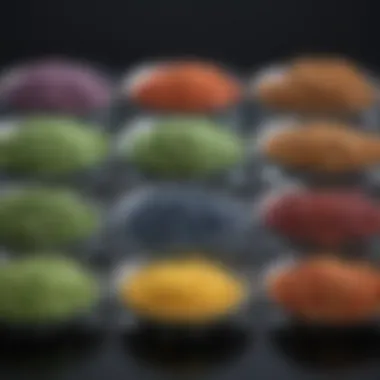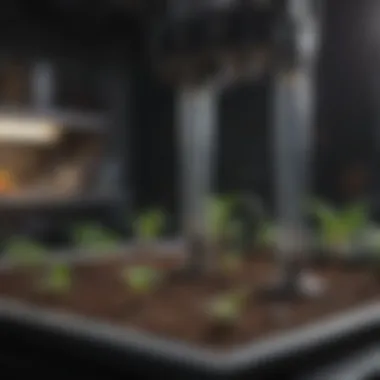Seeding Density in Six-Well Plates Explained


Intro
Seeding density plays a critical role in the outcomes of biological experiments employing six-well plates. This guide aims to shed light on the nuances of cell seeding in these plates. Appropriate seeding density ensures that experiments yield reliable and reproducible data, a fundamental aspect for any researcher.
Understanding how to effectively manage cell density can significantly impact experimental design and interpretations. This article covers key concepts related to seeding density, discusses current trends in research, and presents actionable guidelines for optimization. Below, we explore the essential principles that underline our understanding of seeding density.
Prolusion to Seeding Density
Seeding density is a fundamental concept in cell culture that significantly influences the outcomes of biological experiments. In research utilizing six-well plates, proper understanding and application of seeding density ensure reliable and reproducible results. Too few or too many cells can lead to misleading conclusions, thus emphasizing the need for careful consideration and adjustment.
Definition of Seeding Density
Seeding density refers to the number of cells placed in a given space, typically measured in cells per square centimeter. In the context of six-well plates, this density is important because it defines how cells will interact and proliferate. The optimal density can vary based on cell type and experimental goals, making it crucial to identify the right starting point. For example, fibroblasts might thrive at different densities than epithelial cells, highlighting the need for tailored approaches to each experiment.
Relevance in Cell Culture Studies
Understanding seeding density is particularly crucial in cell culture studies for several reasons:
- Cell Growth: The rate of cell proliferation is directly tied to seeding density. A correctly established density allows optimal nutrient uptake and waste removal.
- Cell Interaction: The density affects how cells interact with one another. A crowded environment might induce different signaling pathways compared to sparse seeding.
- Experimental Consistency: Consistent seeding density contributes to the reproducibility of experiments, allowing for comparisons across independent assays.
Proper seeding density is critical to the integrity of experimental data. With the wrong density, results can become ambiguous or invalid, undermining the research project.
Proper seeding density is critical to the integrity of experimental data. With the wrong density, results can become ambiguous or invalid, undermining the research project.
In summary, recognizing the significance of seeding density in six-well plates is a vital step for researchers. It facilitates more focused experimentation while reinforcing the validity and reliability of scientific conclusions.
Understanding Six-Well Plates
Six-well plates are a fundamental tool in cell biology labs. They provide a convenient and efficient framework for growing cells under controlled conditions. The layout consists of six individual wells, allowing researchers to perform multiple experiments simultaneously with varying conditions. Understanding the structure and use of these plates is crucial for optimizing seeding density, which can dramatically impact experimental results.
Structure and Specifications
The six-well plate is typically made from polystyrene, which is suitable for cell attachment and growth. Each well has a standard volume of about 9.6 mL. This size is ideal for many applications, as it allows sufficient space for cell proliferation while also conserving reagents. The dimensions of each well are generally uniform, facilitating consistent conditions across all six experimental setups.
Additionally, the plates come with a clear, flat bottom. This enables optimal observation under a microscope and can be crucial for imaging analysis in experiments focusing on cellular behaviors. Many six-well plates also have surface treatments designed to enhance cell adherence, which is particularly important when growing adherent cell types like fibroblasts or epithelial cells.
Common Applications
Six-well plates are used in a variety of biological research applications. One of the most common uses includes drug testing assays, where different concentrations of a compound can be tested in parallel. This allows for comparative analysis of the drug’s effects on cell viability and growth.
Another significant application is gene expression studies. Researchers can transfect cells in individual wells and measure the resulting expression levels of specific genes under controlled conditions. The ability to run multiple experiments at once makes six-well plates a practical choice for this type of work.
Further, they are also utilized in studies examining cell-cell interactions. By seeding different cell types in adjacent wells or using specialized culture techniques, scientists can investigate how cells communicate and influence each other.
In summary, six-well plates play a crucial role in experimental design in cell biology. Their specifications meet the needs of various applications, while their structure facilitates ease of use in both high-throughput settings and individualized studies.
Factors Affecting Seeding Density
Understanding the factors that influence seeding density is crucial for successful cell culture experiments. A proper seeding density can affect the viability, growth rate, and behavior of cells. Researchers must consider a variety of aspects that may impact density, from cell type to cultivation conditions. This section elaborates on some of the most important factors, providing insight into how they can be optimized for better experimental outcomes.
Cell Type Considerations
Cellular characteristics are fundamental when determining seeding density. Different cell types have unique growth requirements and behaviors. For instance, adherent cells like HEK293 or fibroblasts favor higher densities than suspension cells such as lymphocytes. Understanding the specific requirements of the cell type in question is essential. Failure to account for these differences can lead to inaccurate experimental results.
Furthermore, some cells proliferate quickly, while others have slower growth rates. It’s important to match the seeding density with the expected growth dynamics of the cells. Using the wrong density can lead to overcrowding or sparse growth, both of which can skew experimental data.
Culturing Conditions
Culturing conditions are equally significant in determining appropriate seeding densities. Key aspects to consider include:


Temperature
Temperature plays a vital role in cellular metabolism. Most mammalian cells thrive at 37 degrees Celsius, mimicking physiological conditions. This temperature supports optimal growth and division, allowing cells to maintain their functions effectively. Moreover, lower temperatures can slow down metabolic rates, leading to reduced cell proliferation.
However, some specific experiments may benefit from altering temperature settings. For example, applying a lower temperature might be useful for certain assays to slow down cellular processes, providing more time for observation.
Medium Composition
The composition of the growth medium greatly influences cell health and growth. Media such as DMEM or RPMI 1640 provide essential nutrients and growth factors necessary for optimal cell function. Different cell types have specific nutrient requirements, and the selection of the appropriate medium is critical.
Some media may contain higher concentrations of serum, which can enhance growth. Conversely, too much serum can lead to over-confluencing, impacting experimental consistency. Special formulations might be necessary for specific cell types to ensure optimal growth and behavior.
CO2 Levels
CO2 levels in the incubator maintain the pH of the culture medium. Most mammalian cells require a CO2 concentration of about 5%. This percentage aids in stabilizing the ionic balance and preventing drastic pH shifts in the medium. Maintaining appropriate CO2 levels allows optimal functioning of the cells.
If CO2 levels are compromised, it can lead to abnormal cell growth and behavior, skewing experimental outcomes. Researchers must ensure that regulations of CO2 levels are strictly adhered to when planning experiments.
Experimental Goals
Different experimental goals necessitate variations in seeding density. Some experiments focus on cellular interactions, which might require lower densities to observe specific behaviors such as cell migration or signaling. In contrast, assays that evaluate drug efficacy may necessitate higher densities to ensure statistically significant results. Tailoring seeding density to align with specific research objectives is vital for generating reliable data.
Determining Optimal Seeding Density
Determining the optimal seeding density is crucial in any cell culture experiment, especially when using six-well plates. The density directly impacts cell growth, behavior, and the results obtained from the experiments. Incorrect seeding densities can lead to misleading data or even failed assays, making it essential for researchers to accurately estimate and adjust cell numbers according to their specific experimental requirements.
Initial Density Estimation
The first step in achieving the correct seeding density involves an initial estimation of cell numbers. Researchers must consider the specific cell type they are working with, as different cells have unique growth patterns and preferences. For instance, adherent cells require a certain threshold density to attach and proliferate efficiently.
A common practice for initial estimation includes cell counting using either hemocytometers or automated counters. This initial count informs seeding decisions and helps establish a baseline for further adjustments. Avoiding the underestimation of cell numbers helps prevent issues related to slow growth and experiment failure.
Adjustments Based on Observations
Once the cells are seeded, ongoing observations are vital to ensure that growth and morphology align with experimental expectations. This includes monitoring growth rates, assessing cell morphology, and conducting viability assessments.
Growth Rates
Growth rates provide insight into how quickly cells are proliferating. Monitoring these rates helps researchers adjust seeding density for future experiments. If cells grow too slowly or too quickly, it indicates seeding density might need to be altered. A key characteristic of growth rates is their direct relationship with nutrient availability and space. When cells are crowded, they may compete for nutrients, which can hinder overall growth. Additionally, cell lines can exhibit varying optimal densities; hence, fine-tuning based on growth rates is beneficial.
Cell Morphology
Cell morphology is an essential aspect of monitoring culture conditions, as it indicates health and functionality. Abnormal shapes or sizes can suggest adverse conditions or inappropriate seeding densities. The primary advantage of observing cell morphology is the early detection of problems within the culture. Should cells exhibit overconfluence or detachment, it signals a need to adjust initial seeding density in subsequent experiments. A clear understanding of ideal morphology can lead to improved reliability of results.
Viability Assessments
Viability assessments, such as utilizing trypan blue exclusion or flow cytometry, are fundamental in determining cell well-being. This measurement helps to understand how the seeding density influences overall cell health. A viable culture is more likely to yield meaningful and reproducible data. The unique strength of viability assessments is their ability to quantify live versus dead cells accurately. Knowing this ratio is critical when troubleshooting experiment failures and refining seeding protocol.
Understanding how these elements interplay enables researchers to make informed choices regarding seeding density, ultimately enhancing experimental design and results.
Understanding how these elements interplay enables researchers to make informed choices regarding seeding density, ultimately enhancing experimental design and results.
Overall, careful determination of seeding density, combined with observations and adjustments, lays the foundation for successful cell culture experiments in six-well plates.
Methodologies for Seeding Cells
Understanding the methodologies of seeding cells is crucial. Correct cell seeding is a foundational step in experiments involving six-well plates, influencing various outcomes. Proper techniques ensure reproducibility and reliability of results. One key consideration is accuracy in counting cells. This impacts how cells are distributed in the wells, which is essential for obtaining valid data.
Common methodologies include different cell counting techniques and specific protocols for seeding. Each method has its characteristics. Researchers must select appropriate methodologies based on their experimental aims. This selection process plays a role in achieving desired growth conditions. Let's delve into the specific techniques.
Cell Count Techniques


Accurate determination of cell number is the core for any seeding process. Two prominent techniques are Trypan Blue exclusion and automated cell counters.
Trypan Blue Exclusion
Trypan Blue exclusion is a simple and widely used method in laboratories. It assesses cell viability by using a dye. Living cells will not take up the dye, while dead cells will appear blue. This characteristic makes it a reliable tool for evaluating cell health before seeding. One benefit of this technique is its direct observation of live/dead status, helping researchers make informed decisions about seeding density. However, this method is time-consuming and depends on manual counting, leading to potential human error.
Automated Cell Counters
Automated cell counters provide an alternative to manual cell counting, offering a quicker and more consistent method. Using a light scattering principle, these devices give real-time data about cell concentration. The speed of obtaining results is a significant advantage of automated counters, making them popular in busy labs. However, they might not differentiate between viable and non-viable cells as accurately as Trypan Blue exclusion. Hence, researchers should consider the specific requirements of their study while choosing between these two methods.
Seeding Protocols
The seeding protocol is essential for ensuring that cells are plated correctly. Different types of protocols include sequential dilution and direct plating.
Sequential Dilution
Sequential dilution is a structured method. It involves making a series of diluted cell suspensions. This method assists in achieving a precise final concentration in the wells. One core advantage is that it minimizes the risk of errors common in direct methods. Sequential dilution enables the control of cell density, allowing adjustments based on experimental needs. One limitation could be the time involved in preparing multiple dilutions, especially for high-throughput experiments.
Direct Plating
Direct plating is a straightforward approach. It is quick and efficient, particularly for small-scale experiments. In this method, a specific volume of cell suspension is directly added to each well. The advantage lies in its simplicity and speed, making it suitable when time is a crucial factor. However, this method lacks controlled density adjustments, which may lead to over- or under-seeding in some scenarios. Thus, understanding the context of the experiment is essential when selecting this protocol.
Applications of Seeding Density in Research
The concept of seeding density holds significant importance in various research fields, particularly in biological studies. Appropriate cell density is crucial for obtaining reliable and reproducible results. By understanding how to apply and optimize seeding density, researchers can enhance the validity of their findings and therefore drive the success of their experiments. Each research application has its specific requirements and implications for seeding density.
Drug Testing Assays
In the realm of pharmacology, drug testing assays frequently utilize six-well plates as a standard tool. The seeding density directly impacts the sensitivity and reliability of these assays. If the cell density is too high, it may lead to nutrient depletion, leading to altered cell behavior and skewed data. Conversely, too low a density may not reflect the drug's actual effect, as insufficient cells can make detection of drug efficacy challenging.
To achieve accurate results, determining an optimal seeding density is essential. Researchers must conduct preliminary studies to establish a correlation between cell density and drug response. Assessing various concentrations of cells before running the actual assay allows for better estimation and comparison of findings. One effective strategy is the use of dose-response curves that illustrate how different densities affect drug efficacy, providing useful insights for further experiments.
Gene Expression Studies
Gene expression studies often require precise control over seeding density. Certain genes may be regulated by the cell's environment, and alterations in density can influence their expression patterns significantly. The interaction of cells with the extracellular matrix and signaling molecules changes depending on the density of the cells, impacting gene activation or suppression.
A common approach in these studies is to vary the seeding density systematically. This helps in determining how the density affects specific gene expression levels. It is advisable to use techniques like quantitative PCR to accurately measure gene expression across different cell densities. Maintaining consistency in the experimental setup is crucial, as even slight variations in density can lead to misleading conclusions and affect reproducibility of results.
Cell-Cell Interactions
Cell-cell interactions are critical in many biological processes, including differentiation, migration, and tissue formation. The seeding density can profoundly influence these interactions, thereby affecting the phenotype and behavior of the cells under study. A higher density can intensify communications among cells, enhancing signaling pathways relevant to development and disease progression.
Researchers should take into account how seeding density can impact the formation of cellular structures such as tight junctions or gap junctions. It is important to establish optimal densities that allow cells to interact naturally without overcrowding, which can lead to stress and artificial signaling influences.
By systematically varying seeding densities, researchers can better analyze the dynamics of cell-to-cell communication and its implications in both health and disease. Detailed observation of these interactions sheds light on fundamental biological processes and may contribute to novel therapeutic strategies.
Proper understanding of seeding density is essential to accurately interpret experimental outcomes and advance biological knowledge.
Proper understanding of seeding density is essential to accurately interpret experimental outcomes and advance biological knowledge.
Common Mistakes and Troubleshooting
Understanding the common pitfalls in seeding density is essential for any researcher or student involved in cell culture. Recognizing and troubleshooting these mistakes can vastly improve experimental outcomes. It allows for the creation of a reliable experimental setup and mitigates the risk of failed experiments based on improper cell density.
Mistakes in seeding density can often lead to inconclusive or misleading results. Therefore, addressing them is not merely a matter of procedure but crucial for the integrity of scientific research. Knowing the typical errors can save time and resources, enabling one to focus on advancing the research objectives.
Overconfluence Issues
Overconfluence occurs when cells in a six-well plate grow in numbers beyond the optimal density. This situation can lead to competition for nutrients and space, which directly affects cell health. The consequence of overconfluence may include altered cell morphology, reduced viability, and impaired function.


When cells become overconfluent, they may stop proliferating or alter their growth patterns. These changes can skew experimental results, particularly in studies focused on cell behavior, gene expression, or drug response.
Researchers should monitor cell growth regularly and adjust the seeding density accordingly. A common strategy is to use a cell counting method, such as Trypan Blue exclusion, to assess the health of the culture before it becomes too dense.
Here are some strategies to mitigate overconfluence:
- Regularly check cell morphology under a microscope.
- Perform cell counts as needed to stay within the optimal density range.
- Plan for timely subculturing or splitting of cells when they approach confluence.
Underseeding Consequences
Underseeding refers to the practice of placing too few cells in a well, resulting in low cell density. This can lead to several issues, including inconsistent results and variability in experimental outcomes. Inadequate cells may struggle to reach confluence, prolonging the timeline of experiments and potentially diminishing the statistical power of the results.
Low cell density can also affect metabolic activity. Cells require a minimum number to maintain communication and exhibit proper behavior, which is especially important in assays for drug testing or gene expression studies. When cells are too sparse, the biological signals necessary for robust responses may not be present.
To avoid the pitfalls of underseeding, researchers must determine the optimal starting density based on the specific requirements of their study:
- Estimate initial cell density based on published literature or preliminary experiments.
- Use controls to validate the behavior of cells at different densities.
- Regularly assess growth to ensure cells are proliferating properly.
"Understanding the balance of seeding density is key to experimental reliability."
"Understanding the balance of seeding density is key to experimental reliability."
Improving the understanding of both overconfluence and underseeding equips researchers with the knowledge to enhance their methodologies and optimize their experiments effectively.
Ending
The conclusion is a critical part of any comprehensive guide as it ties together the key insights gleaned from the discussion. In this article, it emphasizes the importance of seeding density in six-well plates for achieving accurate and replicable experimental results. Proper understanding of seeding density not only enhances researcher confidence but also directly impacts the integrity of scientific findings.
Summary of Best Practices
Best practices for seeding density ensure optimal growth conditions and data reliability. Here are some essential points:
- Cell Type: Different cell types have unique growth requirements. Understanding these needs allows for appropriate adjustments in density.
- Regular Monitoring: Consistently assess cell morphology and viability through the culture period. This helps in making active modifications as required.
- Documentation: Record all experimental parameters and outcomes. This provides a solid reference for refining future experiments.
- Use of Controls: Include control wells with fixed densities. This provides a baseline to measure the effects of varying conditions on experimental wells.
Implementing these practices can mitigate common pitfalls, ensuring that researchers maintain control over their variables effectively.
Future Directions in Cell Culture
The field of cell culture is evolving rapidly. Future research may explore the following areas:
- Automation in Cell Seeding: Development of automated systems for high-throughput screening can improve precision and reduce human error in seeding density calculations.
- Advanced Culturing Techniques: Exploring the use of 3D culture systems could lead to new insights into cell interactions and behavior, which standard two-dimensional cultures may not capture.
- Personalized Medicine Applications: Understanding cell density's role in drug responses can direct future work in tailored medical treatments, optimizing therapies based on individual cellular responses.
In summary, a firm grasp on seeding density and following best practices remains fundamental. Ongoing research will expand possibilities, leading to improvements not only in laboratory methodologies but also in therapeutic applications.
Importance of Using Quality References
Using quality references enhances the reliability of claims made throughout the article. This includes referencing primary research articles, reviews, and guidelines that discuss relevant methodologies and the impact of seeding density on experimental outcomes. Citing respected sources lends authority to the text and helps to inform readers about established practices.
When selecting references, consider the following aspects:
- Relevance: References must closely relate to seeding density and six-well plates.
- Recency: Using recent publications ensures that the information reflects the latest advancements in the field.
- Credibility: Favor peer-reviewed articles and respected journals for more trustworthy information.
Types of References to Consider
In the study of seeding density, various types of references should be included to present a comprehensive view:
- Primary Research Articles: These articles provide first-hand accounts of original research, offering insights into specific experiments and their findings.
- Review Articles: These summarize current knowledge and trends in cell culture practices, including seeding density considerations.
- Protocols and Guidelines: Established protocols inform best practices in cell culture, addressing specific techniques and methodologies for optimizing seeding densities.
Benefits of Properly Citing References
- Enhances Understanding: Good references help the reader learn more and explore topics in greater depth.
- Improves Reproducibility: By citing specific methodologies, other researchers can accurately replicate studies.
- Establishes Context: References illustrate how the current article fits into the broader scope of existing research, highlighting gaps and prompting further investigation.
Formatting References
Adhering to a consistent citation format is crucial. Many prefer the American Psychological Association (APA) style, but others use formats like Modern Language Association (MLA) or American Medical Association (AMA). Whatever style is chosen, it should be applied consistently throughout the article.
As a part of scientific integrity, ensuring that references are up-to-date and relevant enhances the credibility of the research presented, enabling it to contribute meaningfully to the body of knowledge surrounding seeding density in six-well plates.







